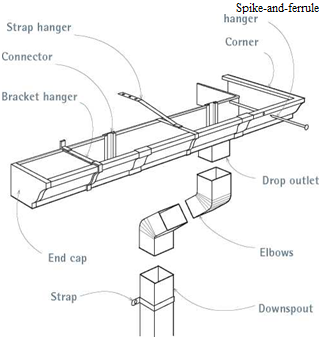Gutter Hangers
Gutter sections need to be supported by hang ers at least every 32 in.; closer if there’s a heavy snow or ice load. The many variations can be grouped into two general types: roof mounted, which employ a strap nailed to roof sheathing, and fascia mounted, which screw or nail directly to fascia boards or rafter tails. Whatever type hanger you use, gutters are less likely to pull free if you nail or screw the attachers to framing behind the fascia or roof sheathing. Here are profiles of four common hanger types:
► Spike-and-ferrule hangers nail directly into rafter ends or through fascia boards. Although this is a simple system, its detractors point out that 7-in. spikes leave large holes, encourage rot, and—in the end—don’t hold well.
► Roof-mounted strap nailers support gutters well and are an alternative to end-nailing rafters—in fact, they’re the only option when there’s no fascia. If you’re reroofing, nail them to the roof sheathing and apply shingles over them.
Or, if the rafter tails are exposed, nail the straps atop the rafters, and install flashing over the straps to forestall rot.
► Hidden hangers are favored for hanging K-style aluminum gutters. They can be inserted into the gutters on the ground and, thanks to integral screws, attached to the fascia one-handed. But because they clip inside the gutter channels— rather than supporting them underneath—these
|
|
Hidden hangers are commonly used with К-type gutters. They can be prepositioned in the gstter and quickly screwed or nailed to the faseia. Because hangers are not visible, gutter lines are clean.
hangers are best used with heavier, 0.032-in. gutter stock, which is stiffer and less likely to flex or sag than the lighter stock.
![]()

 ► Bracket hangers are usually lag screwed to fascia boards. They range from plain 4-in. brackets that snap over the back gutter lips to cast bronze brackets ornamented with mythical sea creatures. Brackets simplify installation because you can mount them beforehand—snap a chalkline to align them—and then set gutters into them.
► Bracket hangers are usually lag screwed to fascia boards. They range from plain 4-in. brackets that snap over the back gutter lips to cast bronze brackets ornamented with mythical sea creatures. Brackets simplify installation because you can mount them beforehand—snap a chalkline to align them—and then set gutters into them.







Leave a reply